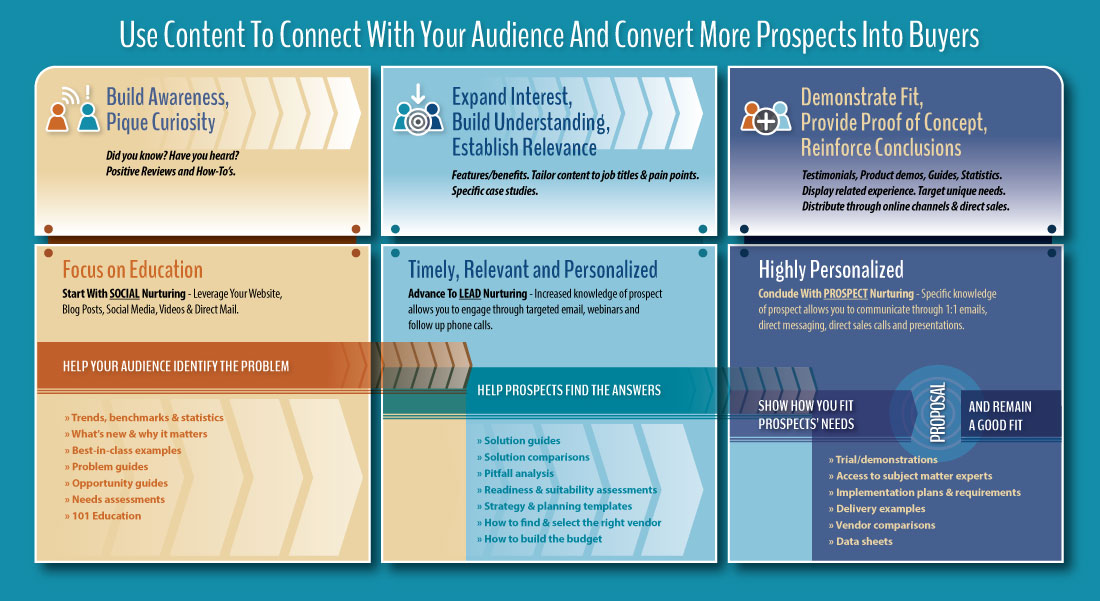Leads. Good leads. The more you have, the more you sell. But, good leads are hard to get.

From trade shows, events, inquiries from your website or even referrals, leads are rarely ready to place an order today. However, with an organized plan that targets each opportunity, you cultivate interested prospects and close more deals. Not sure? Here are 15 lead nurturing statistics and what they mean to your business.
What Is Lead Nurturing?
Have you ever dealt with a sales person that didn't understand your needs? Convincing you to buy today was their only goal. Lead nurturing is the opposite. It fosters relationship building. Through every step of the buyer's journey, lead nurturing keeps you front-and-center with potential buyers. It allows you to build trust over time.
Generating leads means creating selling opportunities that will occur over time. And as these prospects are forming decisions online, and sometimes without your knowledge, building understanding and trust is essential.
These Lead Nurturing Statistics Illustrate That Prospects Aren't Ready To Buy Today
- Only 10 - 20% of trade show leads are sales ready. 70% are worth further attention but take up to two years to reach a decision
- 63% of people requesting information on your company today will not purchase for at least three months – and 20% will take more than 12 months to buy
- On average, a lead takes 11 touches before a deal closes
- An enterprise buyer is 57% of the way to a purchasing decision before they connect with a supplier they are considering
What This Means To Your Business
If you actively generate leads, you lose revenue without a lead generation program. Only a small percentage of prospects are ready to engage in purchasing discussions. Throwing leads over to sales helps, but just slightly. The best option - a program that delivers relevant information to the prospect based on where they are in the purchasing process.
Using Sales For All Lead Follow Up Is A Bad Strategy
- 44% of salespeople give up after one follow-up. But 80% of sales require five or more follow-ups
- 79% of marketing leads never convert into sales. Lack of lead nurturing is the common cause of this poor performance
- Sales reps ignore 50% of marketing leads
- On average, 15% to 20% of the “not yet ready to purchase” opportunities converted to sales after lead nurturing
What This Means To Your Business
Your sales force excels at converting interested prospects into customers. A sales rep should be selling, not spending time qualifying leads. Unlike sales teams, effective lead nurturing keeps your capabilities top of mind with prospects who aren’t yet sales-ready. This increases the amount of prospects that ultimately buy from you.
Plus, including your sales team in the process is simple. Nurturing emails are easily designed so they are personalized “from” the assigned rep.
Lead Nurturing Increases Sales Opportunities, Purchase Amount And Lowers Cost
- Nurtured leads produce, on average, a 20% increase in sales opportunities versus non-nurtured leads
- Nurtured leads make 47% larger purchases than non-nurtured leads
- Companies that excel at lead nurturing generate 50% more sales ready leads at a 33% lower cost
What This Means To Your Business
Providing relevant, timely, personalized information increases a prospects interest in you. This nurturing process has proven to convert more prospects into customers and deepen relationships with current customers. Effective lead nurturing increases sales ready leads and the amount new paying customers. Lastly, it's cost effective and helps you stretch your marketing dollars.
What’s The Next Step?
These lead nurturing statistics show that if you’d like to expand the share of wallet with current customers and generate more viable opportunities from the leads you collect today, a lead nurturing program is worth implementing.
Need a plan? Schedule a demo and we'll show you how.



 Insight Delivered Directly to You Interesting topics, great offers and free marketing tools.
Insight Delivered Directly to You Interesting topics, great offers and free marketing tools.

